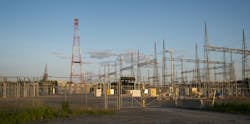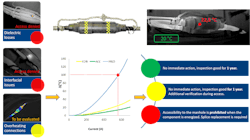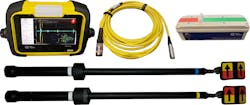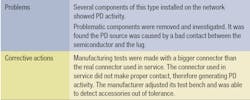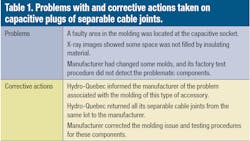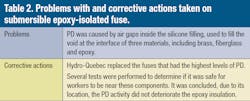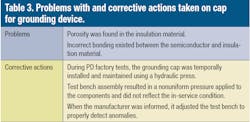Hydro-Quebec Develops MV Test Tools for Underground Distribution Accessories
Medium-voltage underground cable systems are a critical part of the electric distribution network. Like any other power apparatus, the insulation of these underground cable systems ages over time. In North America, many underground cross-linked polyethylene (XLPE) cables were installed in the 1970s and 1980s, with a reported design life in the range of 30 years to 40 years. Nowadays, utilities are faced with underground distribution systems that are, theoretically, either at the end or past their design life.
The replacement of every piece of equipment and accessory that has reached its theoretical design service life is not an option for both economical and practical reasons. First, newly introduced technologies can lead to higher risk of infant failures. Second, each specimen ages at a different rate depending on the operating and environmental conditions. Therefore, maintenance and diagnostic tests are common practice to assess the health of critical power system assets. This can be challenging for utilities when workers or funding are not available to test every electrical component periodically.
In 2005, Hydro-Quebec found that most in-service failures in its underground distribution network occurred at cable joints. A common cause of deterioration in these cable accessories was partial discharges (PD). Therefore, Hydro-Quebec Distribution implemented a thorough inspection procedure to decrease the rate of failure in its underground distribution network. Among other tools, a multilevel PD detection approach was adopted to minimize the need for expertise on-site. Several case examples highlight the advantages of such an inspection procedure for the underground system.
PD Theory
At a basic level, PD is a localized dielectric breakdown of a small portion of an insulation system under electrical stress. Partial discharges can occur when the local electric field exceeds the local dielectric strength at a given location, within or at the surface of an energized object.
Each PD event generates a current pulse. At its origin, if the discharge occurs in atmospheric air, this pulse has a rise time of just a few nanoseconds and contains a theoretical constant broad frequency spectrum, from direct current to up to several hundred of megahertz. Therefore, PD can be detected using different technologies.'
The IEC 60270 standard defines the broad lines of PD measurements in many electrical apparatuses. It specifies the test circuit, type of sensors, measured frequency range and apparent charge (in picocoulombs) as the unit to quantify PD activity. The standard is mainly applicable for PD measurements performed in controlled environments, such as in a factory or laboratory, where interferences can be mitigated easily. PD measurements that comply with IEC 60270 commonly are referred to as conventional PD measurements.
For PD measurements performed in the field, it can be challenging to comply with every requirement of IEC 60270. Space restrictions, a high level of interference and difficulties in performing a valid calibration are among the most common reasons why other techniques are used. These often are defined as unconventional PD measurements and described in IEC 62478.
An example of such measurement is the use of an antenna as a sensor. The antenna is installed on the surface or near an equipment and captures part of the energy from the electromagnetic wave generated by the discharge activity. In this case, many factors can influence the measured quantity; therefore, the assessment usually is focused on whether PD activity is detected rather than quantification of the discharges.
The Inspection Program
Hydro-Quebec has taken steps to become a leader in on-line problem detection over the years. It first started exploring the use of predictive maintenance in 1996 to make access to its underground facilities safer. Now, more than 25 years later, Hydro-Quebec has a mature and sophisticated preventive inspection program in place that makes it possible to target any potential anomaly of an accessory before a failure in service occurs. It also provides workers with safe access to underground facilities.
Every vault is inspected once every six years, and 30 teams are dedicated to conducting this inspection program. It represents an annual inspection of more than 100,000 accessories in 12,000 vaults. Every vault inspected without any anomaly is given an access validity period of one year. Along with these inspections, several hundred repairs a year must be made in vaults that do not have this period of validity and require an emergency inspection.
A vault inspection is broken down into four phases:
- Measurement of potentially harmful and combustible gases.
- Thermographic measurements of low-voltage (LV)
and MV components to identify hot spots. - PD measurements on MV accessories.
- 360-degree photo capture integrated into an interactive 3-D experience tool to help plan, visualize and evaluate events (a virtual tour of underground installations, optimization of work preparation, evaluation of vault degradation, new line routing with fewer field visits).
Depending on the test to be performed, infrared or 360-degree imaging, the device is fixed at the end of the pole. The pole is lowered inside the structure. The cameras are connected by cable to a computer in the thermograph truck. An operator handles the cameras, views the infrared images and detects hot spots. Hydro-Quebec has developed a diagnostic software to evaluate the performance of splice connections (that is, the internal temperature of each accessory and the current for which the maximum temperature will be reached, given the type of splice, cable size and ambient temperature).
PD measurements are complementary to the thermographic inspection. If no anomaly is detected by thermography, PD measurement is done on all the MV components present inside the underground vault. On-line PD measurements made by Hydro-Quebec in its maintenance program are nonconventional, which means only the presence of PD in an accessory is measured, not the charge in picocoulombs.
A PD sniffer has been designed specifically by Hydro-Quebec for use by nonexpert workers as a first-level safety tool. It can recognize a PD signal in a fully automatic manner without any interpretation. Recently, the PD sniffer has been replaced gradually by a new lighter, less expensive PD alarm tool, also developed by Hydro-Quebec.
The PD alarm can detect the inversion of polarity of a PD produced between two antennas at a range of operation below 30 MHz and centered around 18 MHz. This low-band frequency allows much more standard and cheaper electronics for all necessary treatments than at higher frequencies. The development of antennas also is one of the keys to success.
When potential PD is detected by a thermographer, the person leaves the vault and calls the technical team of engineers for validation. An engineer then uses an advanced system, the partial discharge analyzer (PDA), to confirm or deny the presence of PD.
Case Studies
Over the years, PD measurements have enabled Hydro-Quebec to detect dielectric anomalies on not only aging underground accessories but also those newly installed in the network. This has helped to avoid worker exposure to imminent risk as well as breakdowns and associated costs by removing these problematic accessories before a failure occurs in service.
Most cases are caused by improper assembly while a minority are caused by manufacturing issues. However, manufacturing issues can have a greater negative impact on the network. Although factory tests are carried out by manufacturers of electrical distribution products, sometimes a dielectric fault is detected on the accessory installed in the network. These latter cases are the most interesting because they are the subject of a more in-depth analysis. Following are some examples of problematic accessories that have passed manufacturers’ tests and been installed in a network.
600-A Molded Bus Bar
Hydro-Quebec line workers install 600-A molded bus bars in vaults to interconnect molded fuses and transformers. They also are part of a multichannel solid dielectric switchgear deployed on the utility’s network.
With the PD sniffer tool, Hydro-Quebec thermographers noticed probable PD on molded bus bars installed in vaults. An expert engineer confirmed the presence of PD with the PDA system. He also used the PD alarm tool, which indicated the presence of PD. After removal, a phase-resolved partial discharge (PRPD) analysis was done on the defective units with the OMICRON MPD 600 system. It clearly showed the presence of PD.
Almost at the same time, the engineer in charge of testing all new equipment prior to field installation measured and confirmed the PD on multichannel dielectric switchgear, also using the OMICRON MPD 600 system. Doing some open-close operations on the switchgear, the test engineer determined the PD was coming from the bus work of the apparatus but could not tell which component of the bus work was defective. To finalize his analysis, the test engineer used the PD alarm tool to locate the defective part of the bus work: a 600-A molded bus bar.
Following this event, Hydro-Quebec carried out PD measurements on new accessories from this manufacturer. This survey confirmed the presence of PD activity on a high percentage of the analyzed accessories.
Based on the PRPD analysis done on the tested molded bus bars, the test engineer suspected the PD was created by a porosity in the insulation material. X-ray images were taken on three defective molded bus bars and the verdict on all of them was the same: Porosities existed in the insulation at one end of the molded bus bar. The manufacturer analyzed and dissected the returned units, coming to the same conclusion as Hydro-Quebec. The manufacturer took corrective actions on the molding and its PD testing process.
Other Case Studies
The sequence of events taken for the other cases shared here was the same as in the 600-A molded bus bar case study:
- Workers detected the presence of PD on an accessory installed in the field using the PD sniffer or PD alarm tool.
- The presence of PD was confirmed by the technical support team with the PDA system.
- The defective accessory was removed from the underground system and replaced.
- When several identical cases were detected, a PRPD analysis was done in a laboratory.
- Sometimes an X-ray scan of the accessory was done.
- A report on the origin of the PD was written.
- If the PD stemmed from a manufacturing problem, the conclusions were sent to the manufacturer to take corrective action.
Capacitive Plug of Separable Cable Joint
In 2011, Hydro-Quebec observed the presence of PD activity on more than 15 accessories newly installed in its network. For reference, the utility has more than 55,000 units of this type of accessory distributed in more than 3500 underground structures.
Submersible Epoxy-Isolated Fuse
This electrical equipment is used to provide protection for a submersible transformer in the event of an overload or internal failure. Hydro-Quebec has around 2000 fuses of this type installed in more than 500 underground structures.
Cap for Grounding Device
This component is installed on padmounted switches and used to isolate the grounding device.
T-Elbow on MV Switches
This connection accessory, often called a dead-break elbow, is used mainly to connect an underground cable to a switchgear.
Molded Vacuum Switch
This type of switch has been used on Hydro-Quebec’s network since 2010.
Reduced Anomalies Over Time
Hydro-Quebec’s maintenance program achieves various targets. The first of these targets is the health and safety of its employees and the public. By removing potentially dangerous accessories from the network prior to their failure, Hydro-Quebec raises its safety criteria to a high level. It is a priority for the utility.
The second target is economic. The maintenance program reduces in-service failures. Performing a repair after an in-service failure is at least two and a half times more expensive than replacing an accessory after an inspection. In addition, when corrective actions are planned, there is little or no service interruption.
The third target is to ensure quality service and keep monitoring the best practices. This quality assurance has repercussions on the manufacturers. Notifying manufacturers of issues allows them to improve their processes.
Approximately 500 anomalies are detected each year by thermography and 100 anomalies by detection of PD through Hydro-Quebec’s inspection program. Since the beginning of the program, the number of anomalies has greatly decreased.
Michel Trépanier ([email protected]) obtained his engineer’s degree in electrical energy and electrical networks at école de Technologie Supérieure de Montréal (Canada) in 2005. He has been working since 2006 at the underground distribution division for Hydro-Quebec. He acted as technical support engineer for the inspection teams in predictive maintenance, localization and analysis of underground faults. Since 2011, he joined the underground distribution standards department. He specializes in thermal inspection, partial discharge analysis and characterization of medium voltage electrical accessories. He also contributed to several expertise and innovation projects carried out at the research institute of Hydro-Quebec (IREQ).
Claude Tremblay ([email protected]) is an electrical engineer with over than 25 years of experience in engineering and project management at Hydro-Quebec Distribution. Since 2010, Tremblay is actively involved in the standards development for Hydro-Quebec and the Canadian Standards Association. He presently leads a team that provides technical support to his organisation’s project planners and linemen. He is also specialized in conventional PD testing on medium voltage switchgears. Tremblay graduated from Sherbrooke University in 1993 and is a licensed member of the Ordre des ingénieurs du Quebec.
Lionel Reynaud ([email protected]) obtained a University Technological Diploma in Electrical Engineering and Industrial Computering in 1989 and a Master’s degree in Industrial Science at the Institute of Sciences and Technology of St-Quentin in France in 1990. He completed later a Master in Computer Systems at the Higher Institute of Aeronautics and Space in Toulouse in 1991. After a few years as a consultant in the private sector, he became a researcher at the research institute of Hydro-Québec (IREQ) in 1998 and participates in the development of numerous control and monitoring systems. Since 2003 Lionel Reynaud specializes in problems related to cables and accessories of Hydro-Québec’s underground medium voltage distribution network. As a project manager, he leaded the deployment of tools for fault location and partial discharge detection.
Mathieu Lachance ([email protected]) received a Bachelor of Science in electrical engineering from Université Laval in 2014. After graduating, he worked as a test engineer in the fields of partial discharges and high voltage. In 2019, he joined Omicron electronics Canada Corp. where he currently holds the position of Regional Application Specialist for partial discharges and rotating machines for North America. Lachance is a member of the IEEE Dielectrics and Electrical Insulation Society and has published technical papers for IEEE, CIGRE and other industry journals. His current focus is on partial discharge testing and electrical insulation systems.
For More Information
OMICRON | www.omicronenergy.com
About the Author
Mathieu Lachance
Regional Application Specialist OMICRON electronics Canada
Mathieu Lachance received a B.S. Electrical Engineering from Université Laval in 2014. After graduating, he worked as a test engineer in the fields of partial discharges and high voltage. In 2019, he joined Omicron electronics Canada Corp. where he presently holds the position of Regional Application Specialist for rotating machines and partial discharges.
Michel Trépanier
Michel Trépanier obtained his engineer’s degree in electrical energy and electrical networks at École de Technologie Supérieure de Montréal (Canada) in 2005. He has been working since 2006 at the underground distribution division for Hydro-Quebec. He acted as technical support engineer for the inspection teams in predictive maintenance, localization and analysis of underground faults. Since 2011, he joined the underground distribution standards department. He specializes in thermal inspection, partial discharge analysis and characterization of medium voltage electrical accessories. He also contributed to several expertise and innovation projects carried out at the research institute of Hydro-Quebec (IREQ).
Claude Tremblay
Claude Tremblay is an electrical engineer with over than 25 years of experience in engineering and project management at Hydro-Quebec Distribution. Since 2010, Claude is actively involved in the standards development for Hydro-Quebec and the Canadian Standards Association. He presently leads a team that provides technical support to his organization's project planners and linemen. He is also specialized in conventional PD testing on medium voltage switchgears. Claude Tremblay graduated from Sherbrooke University in 1993 and is a licensed member of the Ordre des ingénieurs du Quebec.
Lionel Reynaud
Lionel Reynaud obtained a University Technological Diploma in Electrical Engineering and Industrial Computing in 1989 and a Master's degree in Industrial Science at the Institute of Sciences and Technology of St-Quentin in France in 1990. He completed later a Master in Computer Systems at the Higher Institute of Aeronautics and Space in Toulouse in 1991. After a few years as a consultant in the private sector, he became a researcher at the research institute of Hydro-Québec (IREQ) in 1998 and participates in the development of numerous control and monitoring systems. Since 2003 Lionel Reynaud specializes in problems related to cables and accessories of Hydro-Québec's underground medium voltage distribution network. As a project manager, he leaded the deployment of tools for fault location and partial discharge detection.
